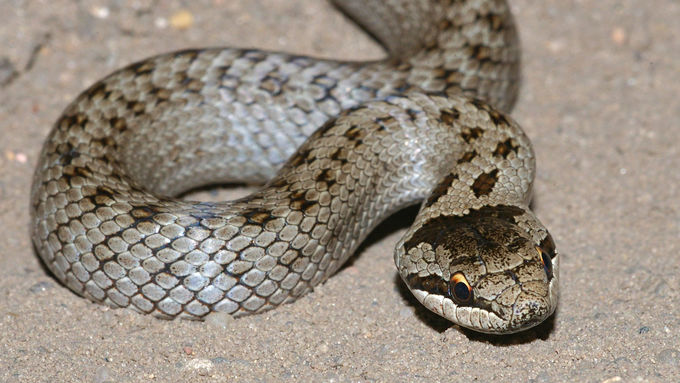Schlingnatter/Smooth Snake (Coronella austriaca) © Christian Fischer, CC BY-SA 3.0
download picturemain content
Protected Species
CORONELLA AUSTRIACA (1283)
Smooth Snake
With a body length of 60 to 75 centimetres, the Smooth Snake is the smallest native snake species. It belongs to the non-venomous colubrid species and is one of the few European constricting snakes. Due to the similar pattern, the species is often confused with the poisonous common adder. An important distinguishing feature are the pupils, which are round in the Smooth Snake and slit vertically in the adder. In addition, the adders have a much stronger zigzag pattern; tail and head are clearly separated from each other. In contrast, Smooth Snakes have a very variable dorsal pattern consisting of two rows of dark spots which may be arranged in pairs or staggered, or in some cases may be almost unspotted; the elongated body seems to merge more or less seamless into the tail. Smooth Snakes are coloured reddish brown to grey. The head and neck drawing is characteristic and consists of a large, dark, almost heart-shaped spot. The ventral side is usually coloured in grey, yellow, brown or reddish.
Habitat and biology
In the northwest German lowlands, the Smooth Snakes original habitats are likely to be the fringe areas of the Atlantic high moors and bright common oak and birch forests interspersed with dwarf shrubs. Today, the species inhabits a number of diverse semi-open or open habitats that are more or less shaped by humans and is regarded as extremely plastic with regard to its requirements. These are often raised bog degeneration stages created by drainage, bright coniferous forests, forest edges, clearings and forest aisles, as well as structured sand heaths, often interspersed with groves. Structured field paths, waysides and railway lines are also part of the habitat spectrum and potential dispersal lines. Grassland, fallow land, neglected grassland, ruderal areas and extraction sites are also used. Typical habitat requirements of the Smooth Snake are sandy or marshy, dry to moist soils with small-scale, mosaic-like changes between vegetation-free areas and areas with sparse to dense vegetation, structural elements such as fallen deadwood, tree stumps, piles of stones and railway ballast as well as a ground inclination and exposure of the abode favouring the microclimate.
After hibernation, the diurnal Smooth Snake moves into the summer habitat from the end of March. From mid-April to mid / end of May, mating takes place. From the end of July to September, the live-bearing female gives birth four to eight, more rarely up to fifteen offspring that feed themselves from the very first day and nourish largely on young lizards, slowworms, or, less frequently, other young snakes. From the beginning of October, the rather sedentary animals usually hide one-by-one in dry, frost-free winter quarters which are usually situated less than two kilometres apart from the other annual habitat. After three to four years, the juveniles become sexually mature. The high juvenile mortality is compensated by the rather high mean life expectancy of the adult animals (over ten years); the maximum life span is about 16 years in the wild.
Occurrence
The Smooth Snake is classified as “Endangered” (EN) in North Rhine-Westphalia and mainly occurs in the mountainous areas. The main distribution range lies in the Bergisches Land and in the Eifel area. In the lowlands of the Atlantic biogeographic region, the species mainly lives in the heath and dry fringe areas of marshes, especially on the Lower Rhine, but occasinally also in the Münsterland.
In Lower Saxony, the Smooth Snake is the rarest snake species and is also listed as “Endangered” in the current Red List (2013). The northwestern area border runs through the Weser-Ems region. The species seems to be missing particularly in many areas in the lowlands west of the Weser. Cohesive points of verification within these regions only exist from the Diepholz area and the southern Emsland. The main distribution is in the Luneburg Heath and in the bogs and extensive pine forests in the Weser-Aller Plains. A certain amount of evidence is also given for the Wesermünde Geest north of Bremen.
Threats
In the north-western lowlands, the species is threatened mainly by intensive agriculture and forestry and by changes in the landscape caused, for example, by the peat cutting industry. These factors also contribute considerably to the further isolation and destruction of smooth snake populations today. In addition, the following factors play a significant role in the decline of the species: reforestation right up to path edges, destruction of protruding fringe areas along woodland margins which are exposed to the sun due to agricultural use or forestry, removal of structures required as hiding places, succession, fragmentation of habitats and isolation of populations due to existing and emerging roads, and management actions in the remaining core habitats which do not consider the needs of reptiles.
Types of action
To improve the conservation status, the following specific implementation actions are required: Removal of seedlings which grow as a result of natural succession on south-exposed railway or canal embankments, in mining pits, on heaths and neglected grasslands, in moor fringe areas or transition zones from open land to forest. It is necessary to create or maintain diverse, structured, natural forest edges and clearings with a semi-open character in sun-exposed location and unshaded margins on both sides of the forest paths, as these provide key habitats and dispersal / connecting structures. In addition, there should be no reforestation in the core areas of the smooth snake and vegetation-free forest areas should be kept open. The temporal and spatial habitat requirements of the smooth snake should be taken into account when drawing up management and development plans or implementing actions.
Actions within phase 1 of the LIFE IP
In the first phase of the project, four actions will be implemented in North Rhine-Westphalia, focusing on improving the conservation status of the smooth snake. These are primarily improvement actions for typical smooth snake habitats, such as the extension of nardus grasslands and the restoration of dune habitats.
In Lower Saxony, five actions focusing on improving the conservation status of the smooth snake will be implemented in the first phase of the project. The actions include the optimisation of habitats by removing seedlings, creating structural elements such as clearance cairns and deadwood or creating new hibernation habitats.
Related Topics
additional information
Further Links
- Species profile „Smooth Snake“ – State Agency for Nature, Environment and Consumer Protection (LANUV NRW) (in German) (external link opens in a new window)
- Implementation notes for the protection of the Smooth Snake – Lower Saxony Water Management, Coastal Defence and Nature Conservation Agency (NLWKN) (in German) (external link opens in a new window)
- Species profile „Smooth Snake“ – German Federal Agency for Nature Conservation (BfN) (in German) (external link opens in a new window)
- German Prioritised Action Frameworks (PAF): Smooth Snake, page 123 – German Federal Agency for Nature Conservation (BfN) (in German) (external link opens in a new window)
- Red Lists and complete species list of Amphibians and Reptiles in Lower Saxony and Bremen (NLWKN) (in German) (external link opens in a new window)




